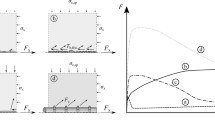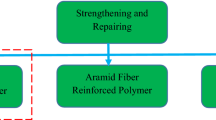Abstract
Cement-based bonded overlay is a frequently used technique for smoothing a damaged surface and/or restoring or improving the mechanical capacity of a structure by increasing its thickness. It is well established that the durability of such a repair is limited by its debonding from the substrate. Whatever the original cause of this debonding, there is general agreement that cracks cutting the repair layer (or any discontinuity such as joints or boundaries) are systematically involved. In situ repairs have demonstrated that reinforcement with commonly used contents of fibres effectively improves the durability of the repair. However, numerous trials under conventional laboratory conditions have failed to confirm the beneficial effects of the fibre reinforcement and three times as much fibre has been required to produce laboratory effects similar to those found in the field. This paper aims to explain this discrepancy. One part of the explanation may be that cracking due to length change (pre-cracking) is not likely to affect small laboratory specimens. Also, most of the laboratory tests have used monotonic loading (or monotonic straining) cases while fatigue loading would constitute a more realistic test. When such corrections are taken into account, a better understanding is obtained of the actual role of fibre reinforcement on the durability of cement-based repairs, as shown by the results and analysis presented here.
Résumé
Une technique courante de resurfaçage, de restaurer et/ou d'augmenter la capacité portante d'une structure est le rechargement adhérent avec un matériau à base de ciment. Il est bien connu que la durabilité de tels rechargements est limitée par leur décollement de leur base. Quelle que soit la cause originale de ce décollement, il est aussi bien acquis que la fissuration dans la couche de rechargement (ou toute autre discontinuité, comme les joints ou les bords) se retrouve systématiquement impliquée. Dans les conditions réelles d'exploitation il s'avère qu'un renfort par des fibres et à des dosages courants améliore la durabilité de telles réparations alors que des essais classiques de laboratoire peinent à montrer l'efficacité d'un tel renfort: il est constaté que des dosages trois fois plus élevés sont nécessaires pour escompter des résultats similaires à ceux obtenus in situ. Cette contribution vise à expliquer cette différence. D'un côté, les petites éprouvettes de laboratoire sont peu sujettes à la fissuration due aux variations dimensionnelles (pré-fissuration) et de l'autre des essais de laboratoire consistent à des sollicitations monotones alors qu'un chargement de fatigue est plus réaliste. Moyennant de telles corrections, les résultats présentés dans cet article ainsi que leur analyse apportent une meilleure compréhension du rôle réel d'un renfort par des fibres sur la durabilité des réparations à base de ciment.
Similar content being viewed by others
References
Vaysburd, A.M., and Emmons, P.H., ‘How to make today's repairs durable for tomorrow-corrosion protection in concrete repair’,Construction and Building Materials 14 (2000) 189–197.
Carter, A., Gurjar, S. and Wong, J., ‘Debonding of highway bridge deck overlays’,Concr. Intern. 24 (7) (2002) 51–58.
Granju, J.-L., ‘Debonding of thin cement-based overlays’,J. Materials in Civil Engng 13 (2) (2001) 114–120.
Granju, J.-L., ‘Thin bonded overlays: about the role of fiber reinforcement on the limitation of their debonding’,Adv. Cement Based Materials 4 (1) (1997) 21–27.
Balouch S. U. and Granju J.-L., ‘Corrosion of different types of steel fibres in SFRC and testing of corrosion inhibitors’, in ‘Infrastructure regeneration and rehabilitation’, Proceedings of an International Conference, Sheffield, June–July 1999 (Sheffield Academic Press, 1999) 861–868.
Betterton, R.M., Knutson, M.J. and Marks, V.J., ‘Fibrous portland cement concrete overlay research in Green County, Iowa’,Transportation research record (1040) (1985) 1–7.
Paulsson, J. and Silfwerbrandt, J., ‘Durability of repaired bridge deck overlays’,Conc. International 20 (2) (1998) 76–82
Verhoeven, K., ‘Thin overlays of steel fiber reinforced concrete and continuously reinforced concrete, state of the art in Belgium’, Proceedings of the 4th International Conference on Concrete Pavement Design and Rehabilitation, Purdue University, West Lafayette, IN, April 1989, 205–219.
Lupien, C., Chanvillard, G., Aïtcin, P.-C. and Gagné, R., ‘Réhabilitation d'une chaussée en béton avec une chape mince en béton renforcé de fibres d'acier’, in: ‘Les techniques de transport au service de la qualité de vie’, Exposé des communications du 25e congrès annuel de l'AQTR, Montréal, Avril 1990, 108–122.
Chanvillard, G. and Aïtcin, P.-C., ‘Thin bonded overlays of fiber-reinforced concrete as a method of rehabilitation of concrete roads’,Canadian J. of Civil Engng 17 (4) (1990) 521–527.
Chanvillard, G., Aïtcin, P.-C. and Lupien, C., ‘Field evaluation of steel-fibre reinforced concrete overlays with bonding mechanism’,Transportation Research Record (1226) (1990) 48–56.
Lupien, C., Chanvillard, G., Aïtcin, P.-C. and Gagné, R., ‘Réhabilitation d'une chaussée par resurfaçage mince adhérent en béton renforcé de fibres d'acier’, Proceedings of AIPCR, comité C-7, Montréal, Canada (1995) 246–250.
Turatsinze, A., Farhat, H. and Granju, J.-L., ‘Influence of autogenous cracking on the durability of repairs by cement-based overlays reinforced with metal fibres’,Mater. Struct. 36 (264) (2003) 673–677.
AFREM, ‘Les bétons de fibres métalliques: Méthode de dimensionnement, essais de caractérisation, de convenance et de contrôle’ (AFREM, Paris, 1995).
Chausson, H. et Granju, J.-L., ‘Rechargement minces adhérents en béton renforcé de fibres métalliques: jeu des fibres dans l'amélioration de leur adhérence au support’, Proceedings of 2e Colloque International francophone sur les bétons renforcés de fibres mécaniques, Toulouse, July 1996 (université Paul Sabatier, Toulouse, 1986) 181–192.
Emmons, P.H., Vaysburd, A.M. and Czarnecki, L., ‘Durability of repair materials: current practice and challenges’, in ‘Brittle matrix composites 6’, Proceedings of an International Symposium, Warsaw, Oct. 2000 (Woodhead publishing limited, Cambridge, 2000) 263–274.
Sabathier, V., Granju, J-L, Bissonnette, B., Turatsinze, A. and Tamtsia, B., ‘Cement-based thin bonded overlays: numerical study of the influence of a bond defect’, in ‘Brittle matrix composites 7’, Proceedings of an International Symposium, Warsaw, Oct. 2003 (Woodhead publishing limited, Cambridge, 2003) 181–189.
Turatsinze, A. and Bascoul, A., ‘Restrained crack widening in mode I crack propagation for mortar and concrete’,Adv. cement based materials 4 (3/4) (1996) 77–92.
Rossi, P. (sous la direction de), ‘Le développement industriel des bétons de fibres métalliques, conclusions et reconclusions’ (Presse de l'École Nationale des Ponts et Chaussées, Paris, 2002).
Zhang, J., Stang, H. and Li, V.C., ‘Fatigue life prediction of fiber reinforced concrete under flexural load’,Int. J. of Fatigue 21 (10) (1999) 1033–1049.
Author information
Authors and Affiliations
Additional information
Editorial note Prof. J.-L. Granju is a RILEM Senior Member. He is also the Chairman of RILEM TC 193-RLS ‘Bonded cement-based material overlays for the repair, the lining or the strengthening of slabs or pavements’. LMDC (Laboratoire Matériaux et Durabilité des Constructions) is a RILEM Titular Member.
Rights and permissions
About this article
Cite this article
Turatsinze, A., Granju, J.L., Sabathier, V. et al. Durability of bonded cement-based overlays: effect of metal fibre reinforcement. Mat. Struct. 38, 321–327 (2005). https://doi.org/10.1007/BF02479297
Received:
Accepted:
Issue Date:
DOI: https://doi.org/10.1007/BF02479297




